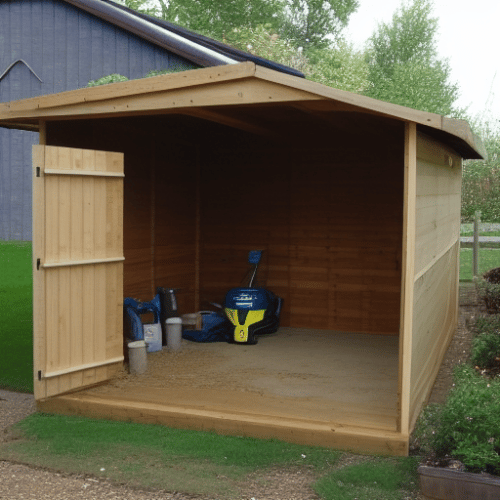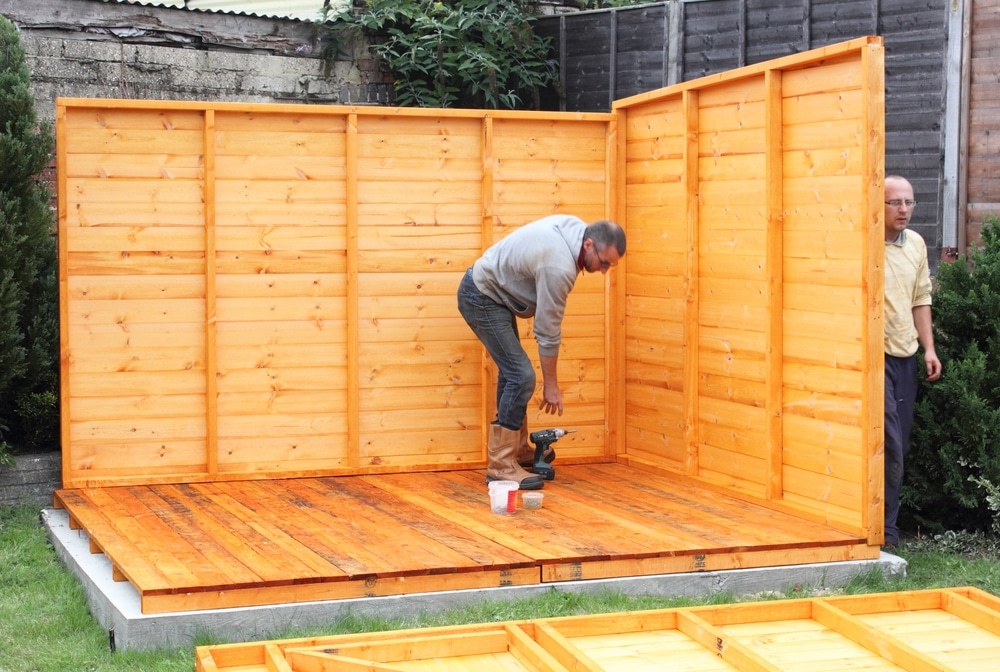Last Updated on
Many people have a garden shed. Sheds are useful buildings for storing garden tools, equipment, or even items like bicycles and sports equipment. However, it is surprising how many people do not have their garden shed on a separate shed base. In this article, we look at why do you need a shed base and the potential problems they help avoid.
The Potential Problems of Not Using a Shed Base
Even if you have a flat and level lawn, it is still usually not a great idea to place a garden shed directly onto it. There are a number of potential problems that might occur. These are generally costly to resolve and could result in having to ultimately replace your garden shed. The following are the common problems associated with not using a shed base:
Rotting Material in Wet Conditions

This problem applies mainly to a wooden shed, but it can affect plastic or metal garden sheds too. Your wooden shed is more vulnerable to damp weather if it is positioned directly on the ground.
Soil and grass retain water after rain. Therefore, the wood touching the ground will quickly become damp and also soak in that surface water. Even pressure-treated wood will still, eventually over time start to rot if it is continually damp.
This rotting will spread and will ultimately compromise the structure of the shed. This could result in holes appearing in the walls and base. In extreme cases, the wooden shed could also collapse. Moreover, your tools and equipment inside will be exposed to the elements.
Ground Subsidence and Leaning
The lack of solid foundations or a solid base may also result in subsidence. You could end up with a garden building that resembles the Leaning Tower of Pisa!
Even if the ground you place the shed on looks suitable, there is no guarantee that it will provide an even weight distribution. For example, a corner of the ground may have undiscovered holes underneath or contain less dense material. Also, parts of the ground may be more susceptible to dampness or sinking.
This may result in your shed sinking and leaning. As a result, it may become unusable and it may damage the items inside.
Damage to Your Lawn
Lastly, sheds without a base may damage your lawn. The weight of the shed, if not distributed properly, may cause parts of your lawn to sink. It may also ruin the quality of the grass and soil underneath. Whilst a shed base will still impact the soil underneath, and it will also evenly distribute the weight of the shed and protect the ground more than an exposed shed.
The Different Types of Shed Base
So what shed bases can you use? Luckily, there is a wide range of shed base types available. These range from inexpensive quick-fit plastic bases to permanent concrete bases. We have listed the five most common shed bases available below:
Concrete Shed Base
A concrete base offers the most permanent and durable solution. However, a concrete base is also the most expensive and difficult option. Unless you have prior experience, creating a concrete slab for your shed will require professional contractors.
A flat area will have to be excavated for the base, and the ground underneath compacted. Steel mesh may also be required to strengthen the concrete. The contractors will then pour the concrete and make sure it is level.
If you use your shed regularly and intend to stay in your home for a long time, a concrete shed floor is the best option. Concrete is incredibly durable and will last for decades. It also provides the most suitable floor for your shed to sit on.
Existing Patio
The simplest method is to use an existing patio! A patio made of concrete or paving slabs provides an excellent foundation for a garden shed. This is because a patio has already been created on stable ground and often has compacted solid or rubble underneath it. It is essentially a pre-made base on which your shed will fit perfectly.
There are considerations, however. Firstly, consider the state, age, and quality of the patio. For example, your patio may be old. There may be a cracked slab, or the cement may be worn, and the slabs may be loose. This may not be the best level base for a shed. Alternatively, a new patio recently laid may be perfect.
Also, look at the positioning. Usually, patios are connected to your house. Therefore, you may not want a garden shed directly outside your home. Alternatively, if you have a patio at the bottom of your garden, this may provide the perfect base.
Ecobase / Plastic Shed Base
Today we are lucky to have some amazing developments in technology. One such technology for gardening is the Ecobase. This is a fantastic shed base design that utilizes a series of plastic grids that interconnect to form a solid surface and base for your shed.
A plastic shed base is an affordable option and one of the easiest to install. You simply order the plastic slabs in a quantity that matches the surface area of your shed. On arrival, you then connect them together in a square configuration. Also, a plastic shed base is lightweight, and durable but can also support a large weight capacity.
The technology has been refined, and some plastic bases can support 60 tonnes per grid! That should be more than enough to hold a shed and heavy garden equipment.
Portabase / Wooden Shed Base
Whilst plastic bases are great, you can also buy a portabase which is a type of wooden shed base. These bases are made from treated timber that has resistant properties and will resist wet ground conditions far better.
The portabase is typically a square wooden frame with slats running parallel inside. They require a little more effort to build, unlike plastic bases. However, they usually have spikes that allow you to anchor the base into the ground.
When using a wooden portabase, it should also be filled with pea gravel. Once the base is installed, make sure the spaces between the slats are filled with pea gravel and compacted. You may also place a strip of gravel around the base. This gravel greatly improves drainage and stops anything growing under the shed base.
Self-Built Shed Base With Paving Slabs
If you are handy with DIY and have some basic construction knowledge, you may construct a base using paving slabs. This does require extra effort and strain, but it may also greatly reduce your costs.
Firstly, the area must be cleared and levelled. This includes removing any grass and debris and marking out the area carefully with string. Always make sure the base has ample overhang on each side.
Once the floor is flattened, you would next create a cement base on which the paving slabs are secured. A simple base mixture is created via a combination of building sand and cement. With the mixture spread, you can finally install the paving slabs. To make sure that you have a level base, use a spirit level when installing the slabs. You can use a hammer to push the slabs into the mixture and level them where needed.
Using a shed base kit or placing your shed on a patio is undoubtedly quicker. However, if you have some spare paving slabs and are confident in your skills, this may be a great method to try.
Conclusion
Don’t be that person who simply builds their garden shed directly onto their lawn! As you can see from the above, laying a shed on your lawn is not the best idea. You are risking an increased chance of rotting, reducing the lifespan of your shed, and potentially damaging the ground underneath and your equipment inside! The benefits are clear, and depending on your circumstance, there is a wide range of shed bases available.
Paul is the type of person who never met a problem he couldn’t fix. He can always be found tinkering with something in his house, even if it isn’t broken! His tips and tricks are often shared on our site. He’s the one you call when something breaks because he has been known to improvise fixes for everything from leaky faucets to malfunctioning dryers.



